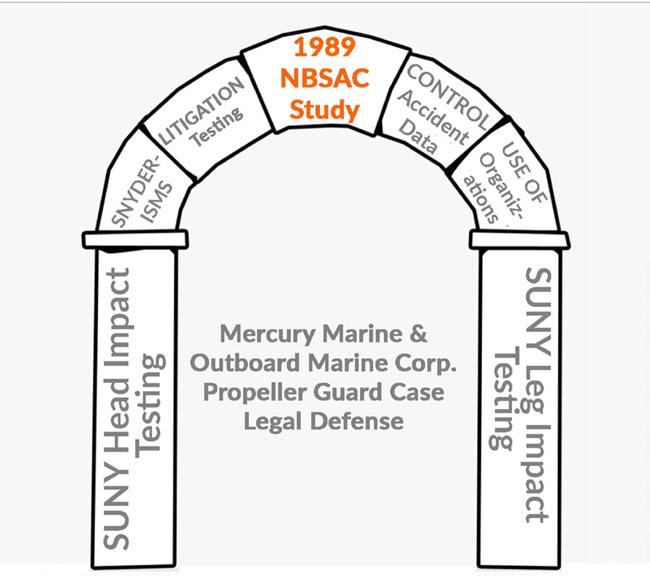1989 NBSAC Propeller Guard Subcommittee Report Vol2
This post is the third of a series of five posts covering the boating industry’s legal defense against boat propeller guard product liability / product defect lawsuits. It focuses on our review of the 1989 U.S. Coast Guard National Boating Safety Advisory Council (NBSAC) Propeller Guard Subcommittee report.
This post is a condensed version of a lengthy pdf report titled Mercury Marine & Outboard Marine Corp. Propeller Guard Case Legal Defense Volume II: The 1989 NBSAC Study that can be found at Boat Propeller Guard Product Liability Defense.
As seen in the image below, the 1989 NBSAC report became the keystone of the boating industry’s legal defense against recreational boat propeller guard product liability / product defect cases.
The introduction to the U.S. Coast Guard’s 1989 National Boating Safety Advisory Council Subcommittee report is copied from Volume II below.
A Brief Introduction to Our Review of the 1989 NBSA Propeller Guard Subcommittee Report
For reasons detailed in the introduction of this four volume series, Mercury Marine / Brunswick and Outboard Marine Corporation (OMC) were facing serious problems on several fronts concerning boat propeller guards about 1988-1991. These challenges forced these two fierce competitors to work together against the financial threat of propeller injury cases.
Along came the U.S. Coast Guard National Boating Safety Advisory Council (NBSAC) in May 1988 announcing they were going to study issues surrounding the use of propeller guards.
Mercury and OMC each had an employee serving on NBSAC. Both men were chosen to serve on NBSAC’s propeller guard subcommittee.
The subcommittee was formed of 5 to 7 men and lasted about a year and a half. Mercury’s representative was Roy Montgomery, their corporate lawyer. OMC’s representative was Richard Lincoln their Director of Public Relations and Director of Environmental Affairs.
In addition to the members above, Richard “Dick” Snyder, long time in house expert witness in boat propeller strike cases for Mercury Marine, attended all three subcommittee meetings, presented at all three meetings, rebutted presentations by others, and sent numerous letters to subcommittee chairman, Jim Getz. Dick Snyder also provided propeller accident statistics to the subcommittee. Mr. Getz was a police captain with Illinois Department of Conservation acting as commander of Lake Michigan enforcement operations.
What Was the 1989 NBSAC Report Worth to the Boating Industry
A finding against use of propeller guards by the NBSAC subcommittee could be worth millions of dollars to Mercury and OMC. The full National Boating Safety Advisory Council and U.S. Coast Guard would likely ratify the subcommittee’s findings. A Coast Guard statement against use of propeller guards could quickly be wielded by Mercury and OMC in boat propeller cases, in the media, and in public debate. “Independent” findings of the U.S. Coast Guard would have tremendous weight in court against Plaintiff’s saying boat motors should have propeller guards. That is in fact what happened.
Three Previously Unexplored Problems With the Report
This volume explores three previously unexplored problems with the 1989 NBSAC subcommittee on propeller guards final report.
Problem #1: the subcommittee was knowingly furnished inaccurate, watered down propeller accident statistics by Mercury Marine.
Problem #2: “Snyderisms – several points frequently made by Dick Snyder, Mercury Marine’s long term in house propeller accident expert witness, made it into the report without being proven or even being attributed to him. Later on, Mercury was able to quote his unattributed statements from the 1989 NBSAC study, giving them even more authority.
Problem #3: Dick Snyder presented Mercury’s project with U.S. Marine Corps to produce propeller guards for Outboard Marine Corporation (OMC) outboard motors as a failure. That was not true.
This volume will cover each of these three problems separately.
